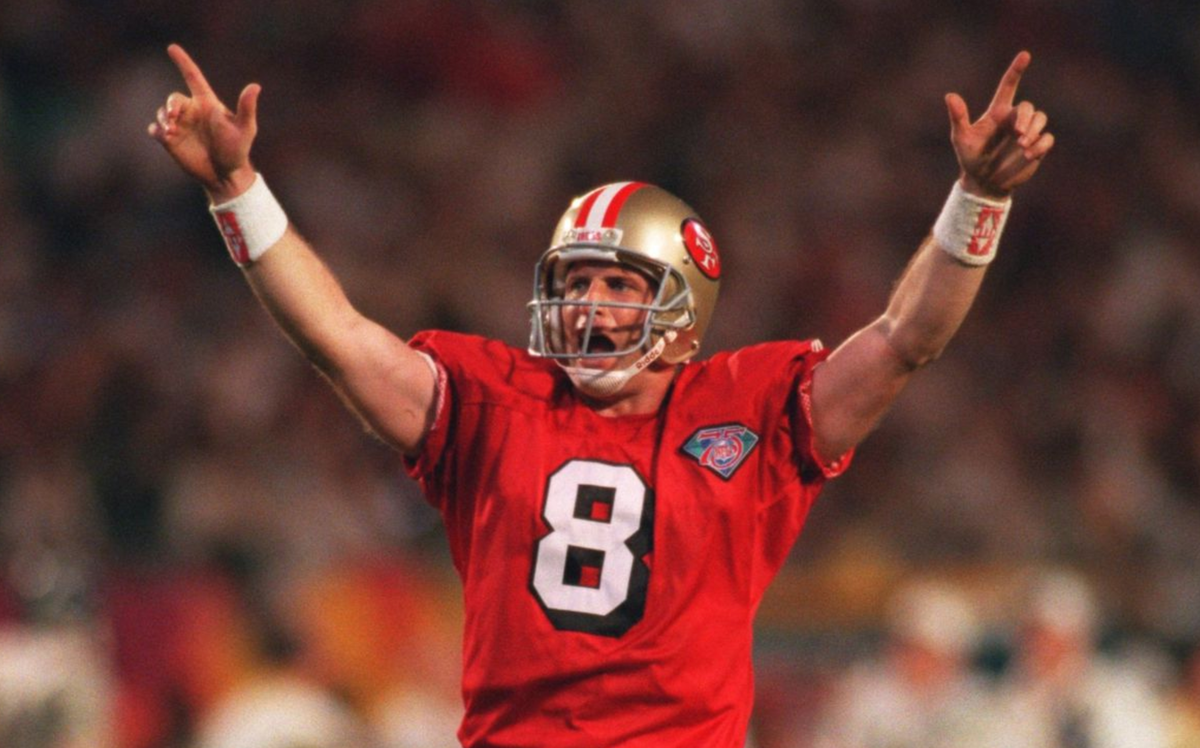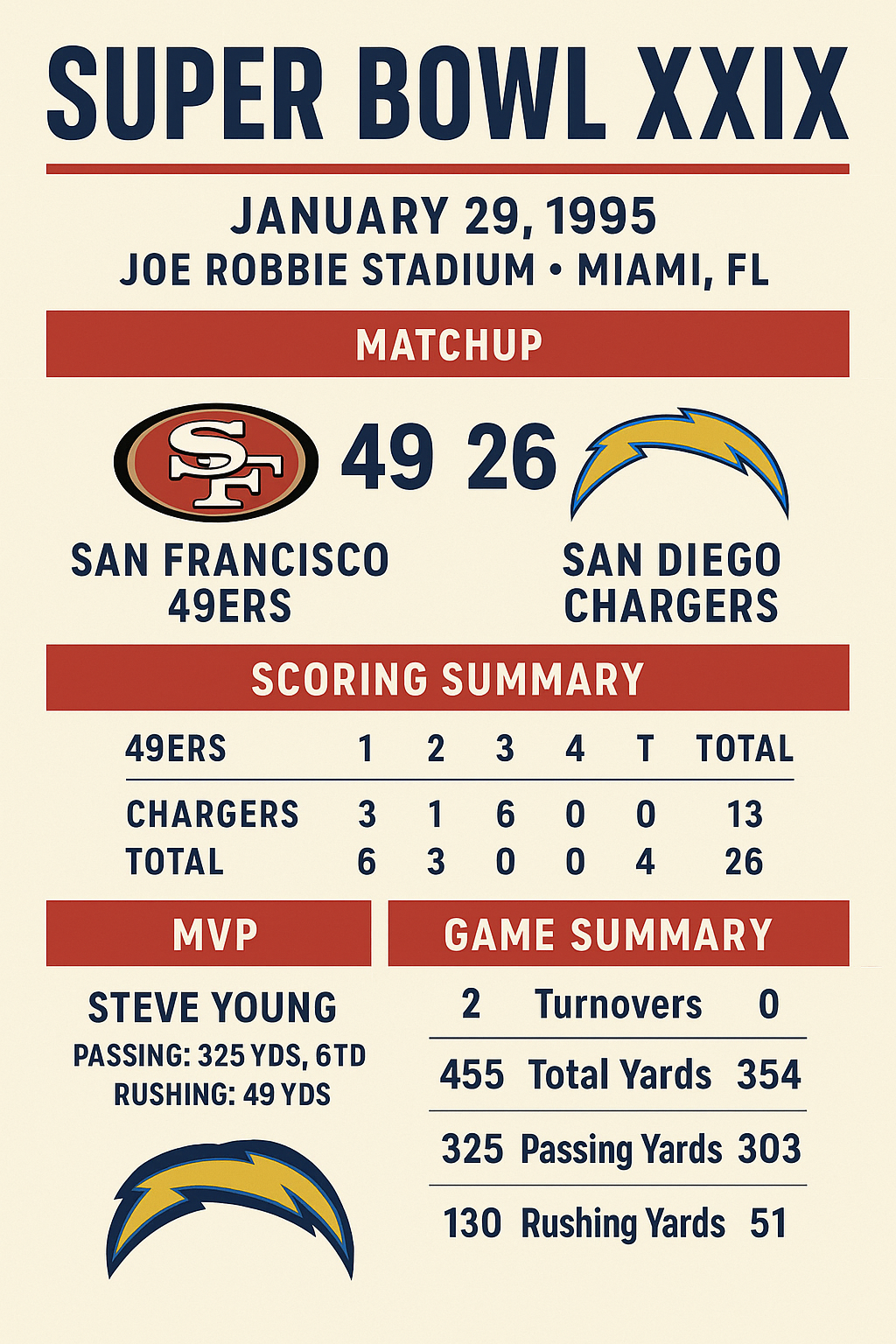Super Bowl XXIX: Steve Young’s Legacy and the Most Dominant Air Attack in Super Bowl History

On January 29, 1995, the NFL witnessed a passing clinic so clinical and overwhelming that it still echoes through the halls of football history. Super Bowl XXIX, held at Joe Robbie Stadium in Miami, Florida, wasn’t just a win for the San Francisco 49ers—it was a coronation for quarterback Steve Young and an emphatic end to the shadow cast by his predecessor, Joe Montana.
“Super Bowl XXIX was less about the final score and more about a quarterback rewriting his narrative,” said Eleanor McKnight, lead historian at the Super Bowl Historical Society. “Steve Young didn’t just win a title—he exploded into legend.”
Pre-Game Narrative: A Legacy in the Making
The 1994 NFL season was shaped by shifting powers and personal storylines. The San Francisco 49ers, led by Steve Young, had fallen short the previous two seasons in the NFC Championship Game—both times against the Dallas Cowboys. The whispers were growing: could Young win the big one, or would he forever be compared to the Montana dynasty?
But in 1994, things clicked. With Jerry Rice still at his dominant best and new additions like running back Ricky Watters and defensive force Ken Norton Jr., San Francisco dominated the regular season (13–3) and exorcised their demons by defeating Dallas in the NFC Championship.
Their opponent, the San Diego Chargers, were the Cinderella story. Led by quarterback Stan Humphries, star linebacker Junior Seau, and head coach Bobby Ross, the Chargers overcame adversity and beat the Pittsburgh Steelers in a stunning AFC title game upset.
Super Bowl XXIX would be San Francisco’s ninth appearance in the big game and a potential fifth Lombardi Trophy—more than any other team at the time.
First Quarter: A Blitz of Greatness
From the first snap, it was clear that this wouldn’t be a close contest. Just 1 minute and 24 seconds into the game, Steve Young found Jerry Rice on a 44-yard touchdown bomb. On the next possession, Young hit Ricky Watters for a 51-yard score.
It was 14–0 San Francisco before San Diego had time to blink.
The 49ers offense operated with the precision of a surgeon and the ruthlessness of a wrecking crew. The West Coast offense was in full flight—slants, screens, deep posts, and play-action burned the Chargers defense repeatedly.
Young threw three touchdowns in the first quarter alone, setting a tone that would never let up.
Second Quarter: Resistance and Response
To their credit, the Chargers didn’t fold. They countered with a touchdown drive of their own, capped off by Natrone Means bulldozing into the end zone and bringing the score to 14–7.
But every time the Chargers showed a spark, the 49ers doused it with fireworks. San Francisco responded with a Ricky Watters 9-yard rushing touchdown, and later in the quarter, Young threw his fourth touchdown pass, again to Rice.
By halftime, the 49ers led 28–10. The game already felt like a foregone conclusion—but for Steve Young, it was only halfway to history.
Second Half: Records and Redemption
Young’s final stat line remains one of the greatest quarterback performances in NFL history:
- 24 of 36 passing
- 325 yards
- 6 touchdown passes
- No interceptions
- 49 rushing yards
He broke Joe Montana’s Super Bowl record of five touchdown passes in a game and became the first quarterback to throw six. Most importantly, he silenced all doubters.
“That wasn’t just a win—it was an exorcism,” said Leroy Chamberlain, senior archivist at the Super Bowl Historical Society. “Young didn’t just fill Montana’s shoes. He sprinted past him with lightning on his heels.”
Ricky Watters added three touchdowns (two receiving, one rushing), while Jerry Rice recorded 10 receptions for 149 yards and 3 touchdowns—cementing his place as the greatest receiver in Super Bowl history.
The final score: San Francisco 49ers 49, San Diego Chargers 26.
Game Summary
| Quarter | 49ers | Chargers |
|---|---|---|
| 1st | 14 | 0 |
| 2nd | 14 | 10 |
| 3rd | 14 | 8 |
| 4th | 7 | 8 |
| Total | 49 | 26 |
San Francisco never trailed and never even looked uncomfortable. They outgained San Diego in total yards (455 to 354) and held the ball for nearly 35 minutes.

Key Stats
- Steve Young: 325 yards, 6 TDs, 49 rushing yards, MVP
- Jerry Rice: 10 catches, 149 yards, 3 TDs
- Ricky Watters: 9 receptions, 61 yards, 2 TDs; 58 rushing yards, 1 TD
- Stan Humphries (Chargers QB): 275 yards, 1 TD, 2 INTs
- Natrone Means: 33 rushing yards, 1 TD
Broadcast and Entertainment
- Network: ABC
- Announcers: Al Michaels, Frank Gifford, and Dan Dierdorf
- National Anthem: Kathie Lee Gifford
- Halftime Show: “Indiana Jones and the Temple of the Forbidden Eye” (produced by Disney)
- Viewership: Estimated 125 million viewers worldwide
Despite a lopsided game, the broadcast numbers soared due to the high-octane offensive display and San Francisco’s popularity.
Historical Impact and Legacy
🏆 Steve Young Steps Out of Montana’s Shadow
For years, Steve Young had lived in the towering shadow of Joe Montana. Despite winning two MVPs before the 1994 season, critics pointed to his lack of postseason success.
Super Bowl XXIX changed that forever. Young’s performance was one of the most complete in the game’s history—accurate, athletic, and ruthless. His place in the Hall of Fame was cemented that night.
🏆 Jerry Rice: The Greatest Receiver Ever
Rice’s three-touchdown night brought his career Super Bowl total to 8 touchdowns, an all-time record. His chemistry with both Montana and Young proved his greatness was quarterback-proof.
🏆 San Francisco’s Fifth Title
With the win, the 49ers became the first franchise to win five Super Bowls, edging out the Steelers (at the time) for most all-time. The team’s sustained excellence across multiple eras (Walsh-Montana, Seifert-Young) established them as a model franchise.
🛑 Chargers Fall Short
While San Diego’s run to the Super Bowl was inspiring, their loss was emphatic. They would not return to the Super Bowl until the 2007 season (Super Bowl XLII), and even that ended in disappointment.
However, players like Junior Seau, who played with immense heart and skill, gained widespread respect. Seau would later be inducted into the Pro Football Hall of Fame.
Postgame Reflections
Steve Young, beaming and holding the Lombardi Trophy, gave one of the most memorable postgame interviews in Super Bowl history. With a relieved smile, he joked:
“Can someone get this monkey off my back?”
That quote summed up the years of expectation and scrutiny he had faced—and just how cathartic this victory was.
Final Thoughts: Super Bowl XXIX’s Place in History
Super Bowl XXIX doesn’t get the same dramatic billing as other close games, but in terms of individual brilliance and narrative closure, it stands among the greats.
The 49ers played with such grace and precision that it almost felt unfair. Young’s performance, Rice’s reliability, and Watters’ explosiveness combined into a perfect storm for the Chargers.
“You could argue that no quarterback has ever had a better Super Bowl,” McKnight added. “Young answered every question—emphatically.”
From a pure football perspective, the game showcased how a team can evolve, rebuild, and dominate, even after losing all-time greats. The 49ers had rebuilt their dynasty on speed, skill, and strategy—and Super Bowl XXIX was their masterpiece.
